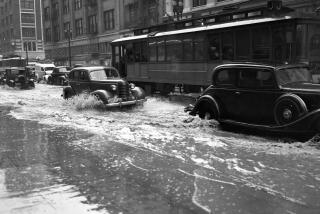Chronicles of a State Foretold
Much of what is written about California has been the work of visitors who bring their own presumptions and prejudices along with them, stay only briefly and then go back home and tell the rest of the world what they think they saw here.
The phenomenon, as we discover in “Lands of Promise and Despair,” is hundreds of years old: The word “California” in fact first appeared in print in 1510, when the Spanish author Garci Rodriguez de Montalvo was inspired by the reports of early New World explorers to conjure up an island paradise where black women in gold armor (their queen was named “Calafia”) procreated with kidnapped sailors. The name came to be attached to the Golden State, which was depicted as an island by early Spanish map makers.
“[S]ometimes, without realizing it, we give foreign authors the last word,” write Rose Marie Beebe and Robert M. Senkewicz, the editors of “Lands of Promise and Despair,” a richly illustrated anthology of witness accounts of the troubled but crucial period when native Californians and Europeans first came into contact with each other. The authors’ self-declared goal--and one that they accomplish with scholarly authority and a flair for storytelling--is to restore to the modern reader “a genuine experience of Spanish and Mexican California from the inside.”
“Lands of Promise and Despair” surveys what we might call the pre-history of California. Much has been written about the era that began with the Gold Rush in 1849, but Europeans had already been here for some 300 years when gold was found at Sutter’s Mill. And the first Spanish conquistadors, of course, encountered a native population whose own history goes back thousands of years and a native culture that had produced an oral tradition so rich that it was expressed in 100 different languages.
Professors at Santa Clara University, Beebe and Senkewicz have selected and collected the most colorful and revealing passages of the oral histories known as testimonios, as well as the letters and journals of explorers and settlers and the official reports of Spanish colonial bureaucrats who saw it all with their own eyes. From the outset, and over the centuries, the constant theme is conquest.
“It is a pleasant place,” wrote explorer Sebastian Vizcaino to the king of Spain about his voyage to the bay he dubbed Monterey in 1602. “The area is very populated by people whom I considered to be meek, gentle, quiet, and quite amenable to conversion to Catholicism and to becoming subjects of Your Majesty.”
Not every Spanish chronicler was quite so confident--or so clueless. When the Jesuits tried to disrupt the traditional leadership of the native Californios by forbidding the local chiefs and shamans to take more than one wife, their followers rose up in rebellion and attacked a string of missions throughout Baja California.
“When the rebels approach they will no doubt give their war cry and kill everyone inside the fortifications,” declared a pair of dispirited Spanish soldiers to a mission priest in 1734. “They are fully aware that our force inside the fort is small and that when our men are killed it will be the end of all this, and then, Father, goodbye to the Californias for many years to come.”
A century later, when the Spanish were gone and California was a province of an independent Mexico, armed resistance was still going on. Resentful of the priestly urgings to be baptized, for example, one band of native Californians attacked a mission in 1840, killed a corporal of the Mexican garrison and went in search of the mission father, who begged his house servant to save his life by sitting on top of him and thus concealing him under her skirts. The scene of his successful concealment, as recalled by the woman herself, is comical and dreadful.
“Father ... begged me for God’s sake not to give him away,” she recalled, “promising me that if the Virgin Mary got him out of that conflict he was in, he would give me everything I might need from then on in order to live leisurely and with no need to serve anyone as long as God remembered me.”
The occasional murder of a soldier or priest, of course, was ultimately futile, as we are constantly reminded in “Lands of Promise and Despair”: The Old World planted itself in the New World, and the original Californians survived only on the ragged edges. Still, here and there, embedded in the writings of Europeans, we find fragments of the oral traditions that were nearly obliterated, including a poignant lament by the Aztec victims of the original Spanish conquistadors:
Broken spears lie in the roads;
we have torn our hair in our grief.
The houses are roofless now, and their walls
are red with blood.
The imperial ambition that inspired the Spanish conquistadors was eventually defeated by an even more forceful one, the doctrine of Manifest Destiny that lured Americans all the way to California. A glimpse is given here in an 1841 letter from Mariano Guadalupe Vallejo, the Mexican commander in charge of the northern district of Alta California, to the Ministry of War in Mexico: “I received word of the arrival at the town of San Jose of a party of thirty-three foreigners from Missouri,” he reported. “I had them appear before me to demand their passports, and I was told that they had none, because they did not deem them necessary....”
Another and especially vivid example of the same phenomenon is offered in “Death Valley in ‘49,” a truly heroic account of what a young man named William Lewis Manly saw on the way to California’s gold fields. Seeking a shortcut, his party blundered into Death Valley, and their gold fever was suddenly replaced with the primal challenge of survival in a desert wilderness.
“A hoard of twenty-dollar gold pieces could now stand before us the whole day long with no temptation to touch a single coin,” wrote Manly, “for its very weight would drag us nearer death.”
First published in 1894, and now offered in a re-edited, annotated and highly readable edition, “Death Valley in ‘49” is the memoir of a man whose real life was as full of adventure as any John Wayne movie or Zane Grey novel. Manly, for example, was an accomplished frontiersman even before he set out for California: “We had to be real Indians in custom and actions in order to be considered their equals,” he writes of the years he spent as a trapper. “We got our food in the same way they did, and so they had nothing to ask us for.”
Once stranded, his courage, skill and tenacity saved the lives of the men, women and children in whose company he was traveling.
“None of us knew exactly where we were, nor when the journey would be ended, nor when substantial relief would come,” he wrote of the worst moments in the place that his party dubbed Death Valley and where several features of the landscape now bear his name. “One fellow said he knew this was the Creator’s dumping place, where he had left the worthless dregs after making a world, and the devil had scraped these together a little.”
“Death Valley in ‘49” is a survival story, of course, but it is also, ultimately, a morality tale, as historian Patricia Nelson Limerick points out in her introduction to the new edition. “Each time Manly traveled ahead in the desert, climbed a mountain, and assessed the prospect ahead, his loyalty was put to the test,” she writes. “Without dependents, he could ‘pick up my knapsack and gun and go off,’ travel fast and save himself. But saving his own life would come at too high a price: ‘I felt I should be morally guilty of murder.’ ”
More to Read
Sign up for our Book Club newsletter
Get the latest news, events and more from the Los Angeles Times Book Club, and help us get L.A. reading and talking.
You may occasionally receive promotional content from the Los Angeles Times.







